One species that I’m excited to work with over the next few years is sekka hinoki, Chamaecyparis obtusa ‘sekka’.
Sekka are a dwarf hinoki cultivar with incredibly small foliage making them a popular choice for cultivation as shohin.
I have a number of sekka hinoki in one gallon nursery containers that need repotting this year. Here’s the process I follow for repotting them.
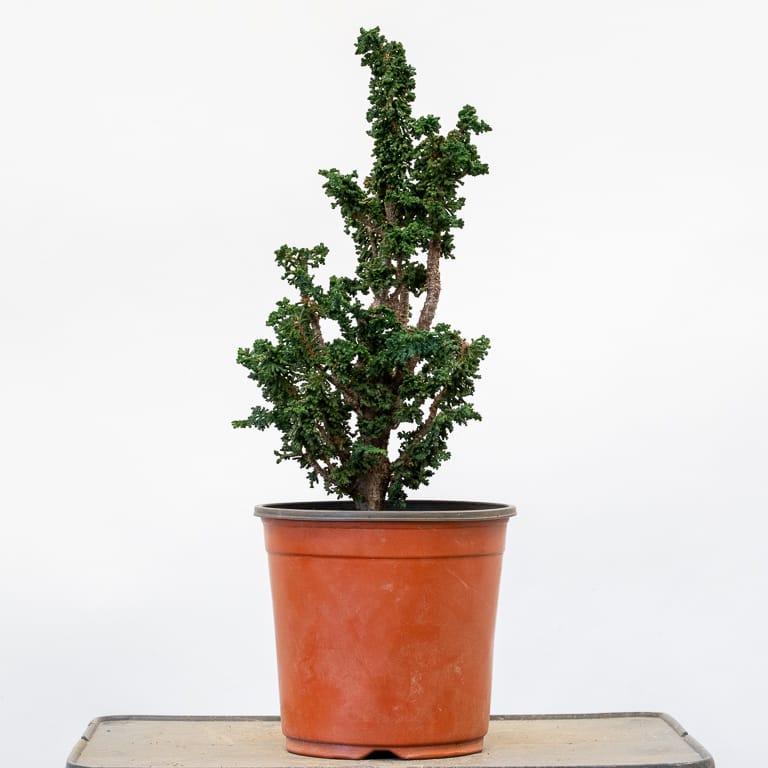
Sekka hinoki
I’d like to repot the tree into a bonsai container, but the shallow dimensions of bonsai pots aren’t deep enough for such a tall root ball.
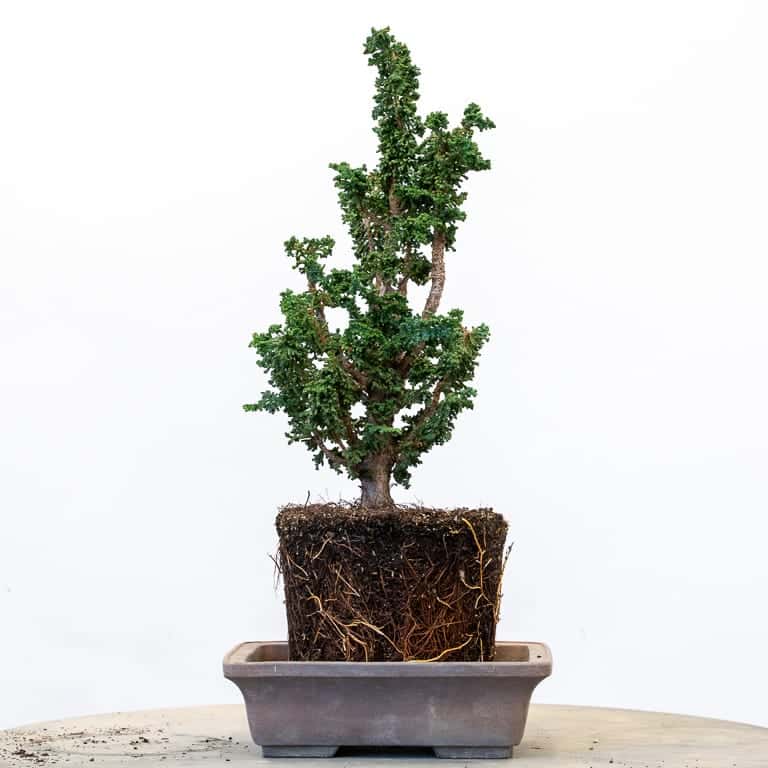
Shallow bonsai pot
In these cases, I can use terra cotta training pots that are deeper than bonsai pots.
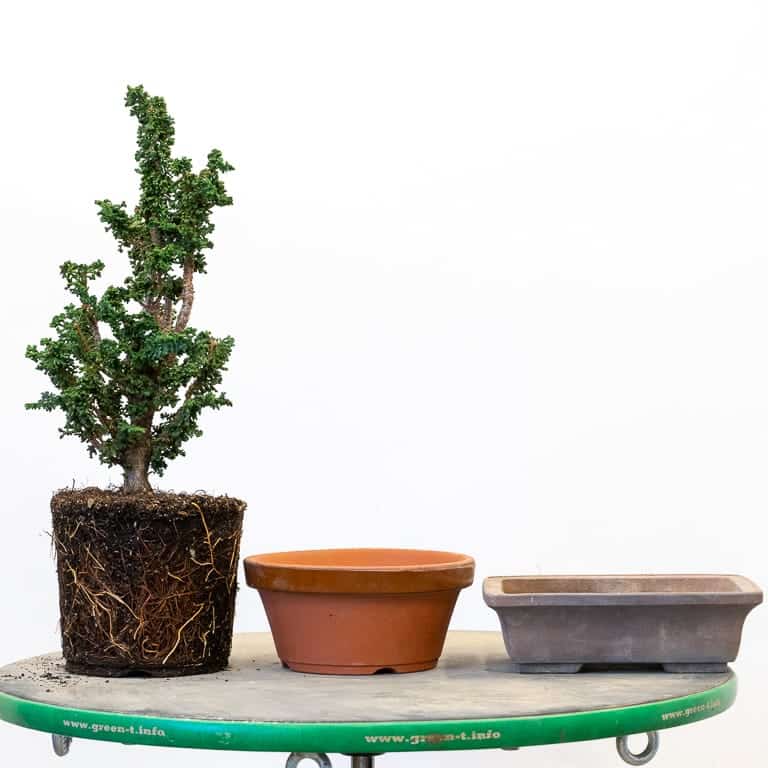
Tree, training pot, and bonsai pot
Fitting the tree into the training pot will require that I reduce the root ball. I begin by removing the top layer of soil until I reach the point where the trunk transitions into lateral roots.
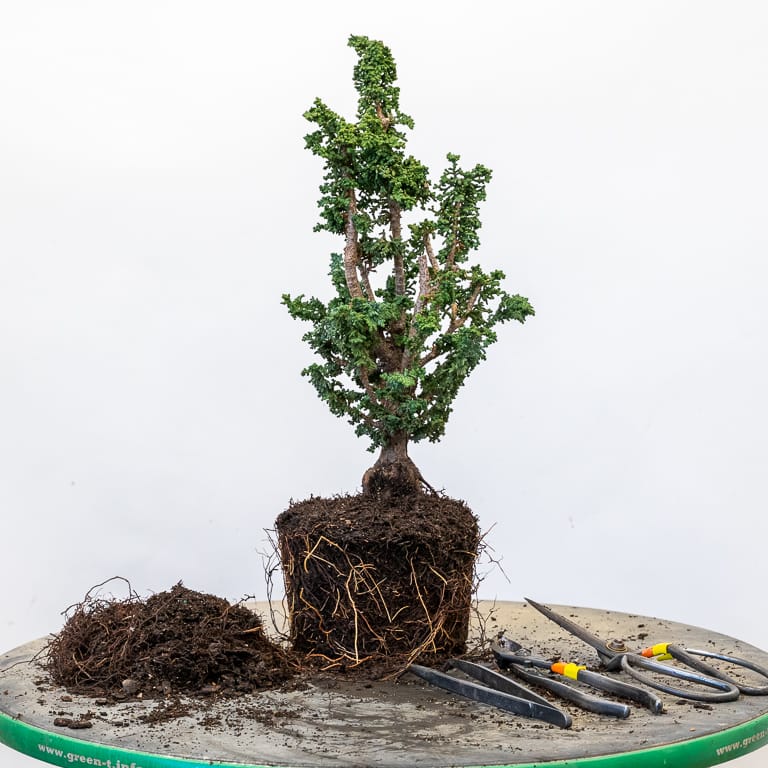
After removing the top layer of soil
This reduced the root ball from five inches tall down to four inches. As the training pot is about three inches deep, I now know how much soil I need to remove from the bottom of the root ball.
I also removed some soil from the sides of the root ball which will help me center the tree in the pot. Here’s the tree after removing an inch of soil from the bottom and a little soil from the sides.
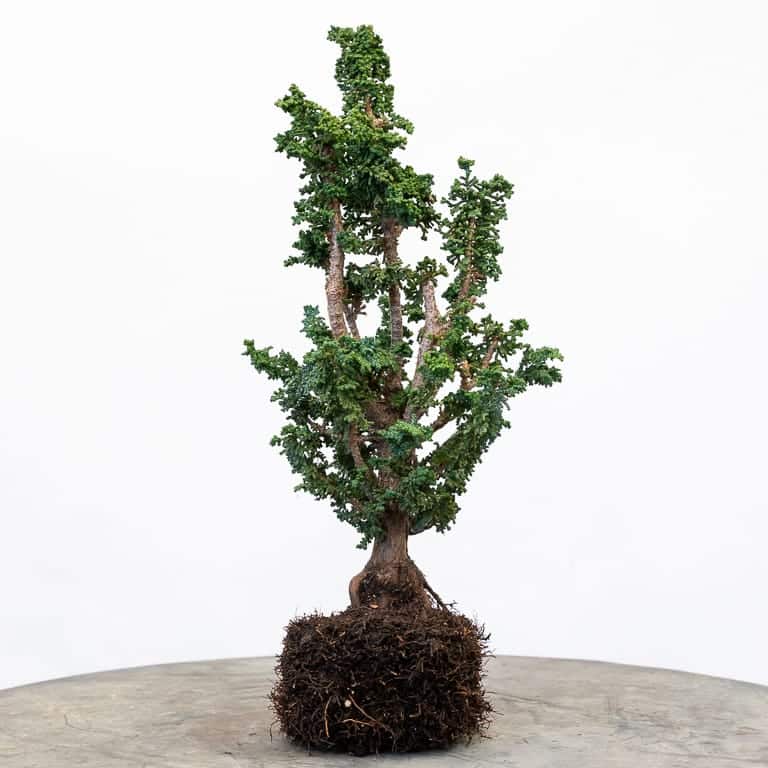
After reducing the bottom and sides of the root ball
Depending on how much room there is in the pot, I remove up to half of the old soil. As the pot I selected doesn’t leave much room for new soil, I combed out approximately 40% of the old soil.
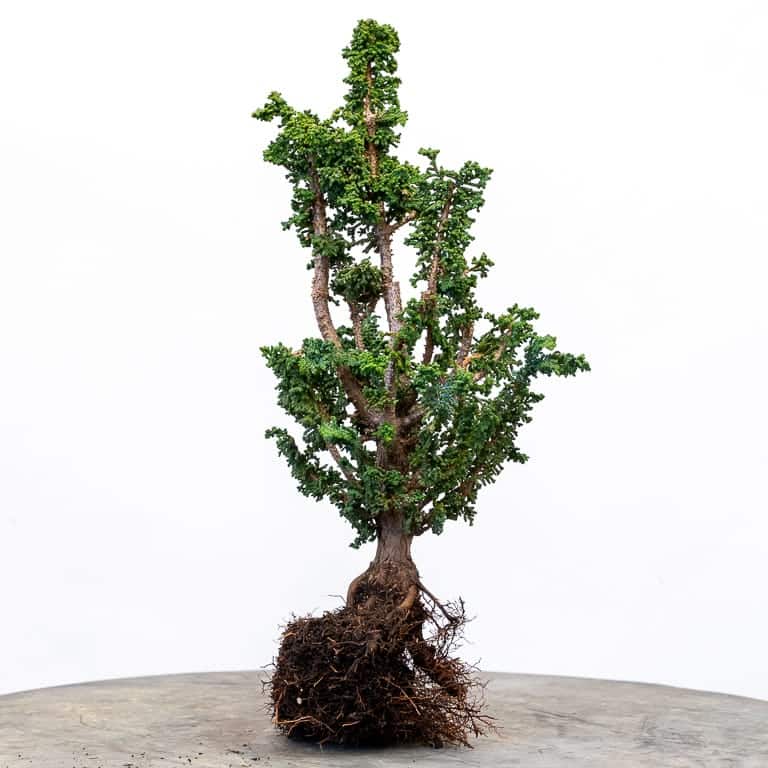
After bare-rooting a portion of the rootball
I secured the tree in the pot with two wires (you can see how this is done here), but before I tightened the wires, I worked soil into the area that had been bare-rooted.
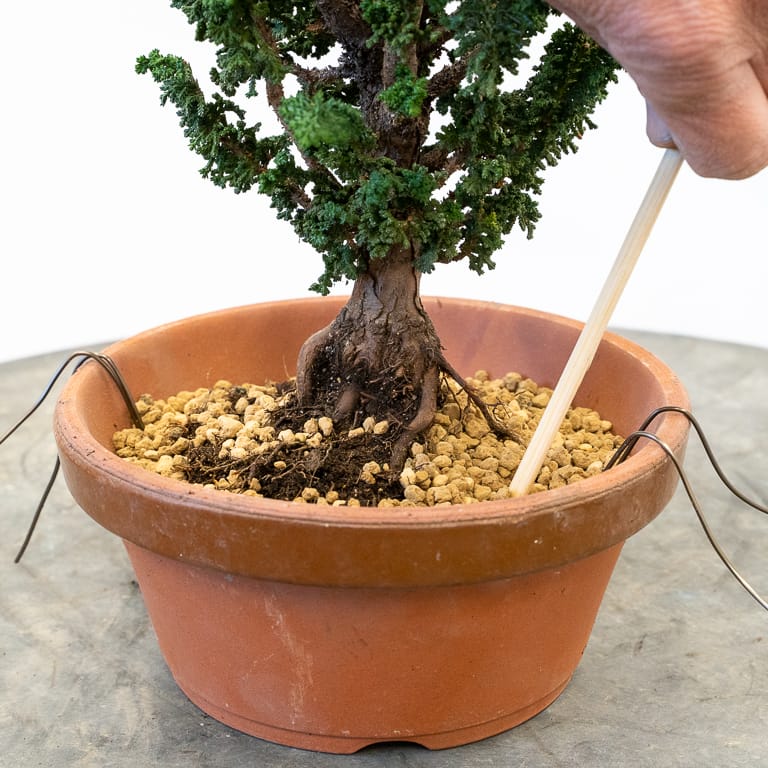
Adding soil before tightening the wires
After securing the tree, I filled the pot with soil.
I repotted similar trees last year using an 80% akadama mix. The trees grew well so I used the same mix this year.
Here’s the tree when the repotting was complete.
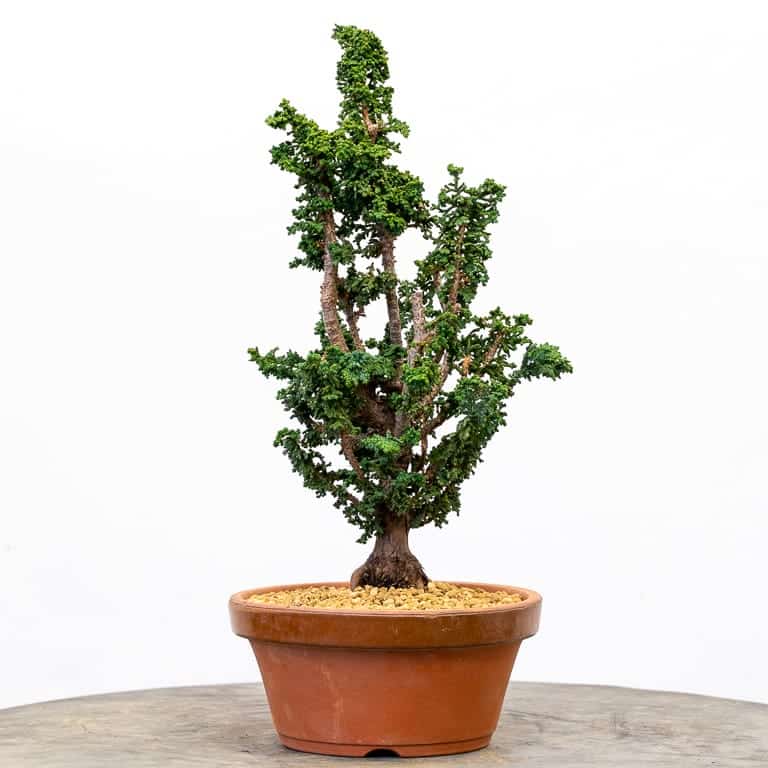
After repotting – 13″
I keep sekka hinoki in full sun year-round and find that they do well as long as they don’t get too dry. Hinoki produce lots of roots so I expect the tree to be ready for pruning and wiring by fall.
Subscribe to Bonsai Tonight
New Posts Delivered Every Tuesday and Friday
Guy says
Thanks Jonas, can you share details on how you manage the foliage. I’ve had one now for two years and it seems to lose more foliage than it puts on, branch development seems very tricky at best as it gets leggier and leggier, there are plenty of new growth areas from the trunk, but these will take time to develop.
Jonas Dupuich says
I’ll have more posts on the topic in the future, but in the meantime, I’ll say that it’s important to clear away any brown foliage in spring and to prune regularly. You can also check out sekka videos on YouTube by Bjorn Bjorholm and Bonsai Shinshi.
James says
Hi Jonas,
I just got a sekka I ordered from Bill V. Mine has a very bad inverse taper at the base. I’m wondering if I could ground layer it when I repot mine in the coming week(s) (Chicago area). Do you know of or have experience doing this successfully with s. hinokis? Or should I wait till the tree is more established and/or wait till mid-summer?
thanks,
Jonas Dupuich says
I’m going to try a number of ground and air layers on sekka this year. The standard time to start layers is May, but I’d guess they’re flexible and could start one as soon as the tree is active in spring.
Gabe says
Love sekka’s, too, Jonas. I have to ask you about some of the statements you make about the percentage of soil you removed; to be clear, I’m not questioning the way you repotted, just the numbers. I can only go by the pictures, but I tried to normalize them and it looks to me like before you start you have an approx. cylinder of rootball that is 7″ diameter and 7″ height; that yields a volume of approx. 270 cubic inches, Once you are done bare rooting half of the rootball you are left with a much smaller cylinder that looks to be approx. 3.2″ in diameter and 3.2″ in height; that yields a volume of approx. 26 cubic inches. That means you removed 90% of the soil and 80% of the roots (you are left with 10% of roots in the soil and 10% bareroot). Am I off?
Jonas Dupuich says
I expect your numbers aren’t far off. I did the exact same approach on fifty sekka last year and was really surprised at how well they grew. I think that about a third of the soil I removed had little to no roots in it, so I likely only removed a fraction of the important roots that were sustaining the trees. Also, if I wanted the trees to respond with more vigor, I would have kept more roots and let the tree grow freely for a few more years. My goal was to see how quickly I could get them in small containers and it turns out it’s possible for them to make a pretty big jump.
Gabe says
That makes 100% sense, Jonas.
Yaroslav says
Do I understand correctly that you tried not to touch half of the root ball so as not to disturb the roots? The sixth photo shows that half of the root ball is almost not cleaned.
Jonas Dupuich says
That’s right – once I trimmed the root ball to size, I removed the soil from a portion of it and I left the rest alone.
Zack Clayton says
Your repot mix is 80% akadama. What is the remaining 20%? More mineral grains or organics? The soil removal photos suggest a fine grain loam or sand.
Jonas Dupuich says
Hi Zack – the remaining 20% in Aoki Blend is pumice with some lava rock. The previous soil used by the grower is mostly sawdust or bark mixed with sand.